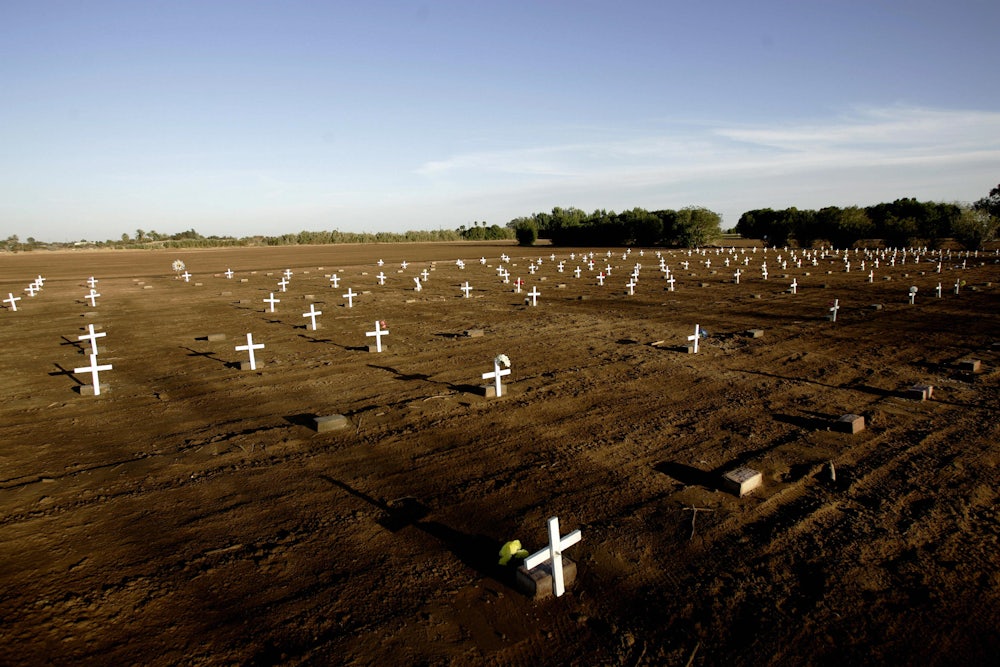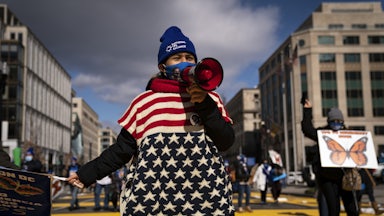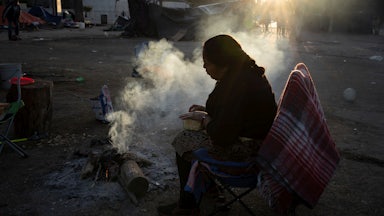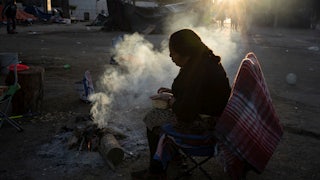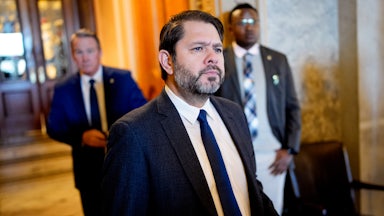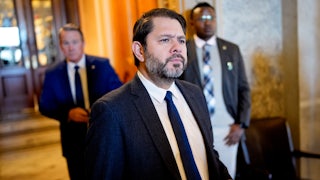It was Selina Sanchez-Cristobal’s day off, but she picked up the phone anyway. It was 2019, and she was the only employee running a 24-hour hotline for migrants who became lost crossing from Mexico to Texas; the calls rarely stopped.
On the line was Danny, a Honduran man in his mid-twenties who had spotted the hotline number on a water station near Falfurrias, about 90 miles from the border. His eye was injured and his clothes were soiled, he said. Sanchez-Cristobal and her friend drove to meet him, helped clean his eye, and gave him fruit, Slim Jims, and fresh clothes.
He started talking about where he’d been: For three days, he had walked through the hot and humid checkerboard of ranchland that covers southern Texas. Before he found the water station, he was lost and thought he might not make it. He saw a Border Patrol helicopter fly over and tried to wave it down. The helicopter shone a light on him, he said, but didn’t pick him up. He felt like he was being left to die.
Sanchez-Cristobal said Danny made it beyond the last Border Patrol checkpoint and reached the U.S. interior. He told them he dreamed of becoming a singer and planned to travel to a major city.
The danger he faced was no accident. The border is not only a line across the land—it extends 100 miles into the United States, through private property, national parks, and reservations. Beginning in the 1990s under a policy called “prevention through deterrence,” Border Patrol set up a series of obstacles—walls, checkpoints, helicopters, fixed towers, license plate readers, and facial recognition—to push migrants onto more deadly routes, mostly through southern Texas and the unforgiving Arizona desert. To avoid being detained or deported, migrants must cross this 100-mile expanse on foot and evade detection to reach the interior of the U.S. Without this policy, Sanchez-Cristobal told me, it would not have been necessary for Danny to walk so far through deadly heat to reach safety.
His route, and the danger it entailed, had been designed for him by decades of federal policy. Different administrations have changed the language used to describe their immigration policies—Bill Clinton said he was “cracking down on illegal immigration,” George W. Bush called his approach “compassionate conservatism,” Barack Obama said he wanted to balance “a nation of laws and a nation of immigrants,” and Donald Trump was openly racist and hostile to immigrants—but deaths at the southern border stay largely the same.
More than 7,800 migrants died in the U.S. borderlands between 1998 and 2019, according to Customs and Border Protection, although this is an undercount of the true number. In Arizona, human remains found by the group Humane Borders reached a seven-year high amid a climate change–fueled megadrought in the southern U.S.
Climate change is also forcing migration north from Central America as hurricanes and crop failures intensify already desperate and violent circumstances (some of which U.S. foreign policy directly contributed to). President Joe Biden has promised to tackle climate change, study the root causes of migration from Central America, and provide a path to citizenship for undocumented people. But his security proposals for the southern border are largely a continuation of prevention through deterrence, a bipartisan legacy of accepting mass death as the price of “border security.” Without major policy overhauls, the deaths will continue. Biden’s predecessors embraced, sometimes gleefully, the fatal status quo. The question now is if he will, too.
We can’t understand U.S. border enforcement without understanding the history of the border. For more than 10,000 years, Indigenous communities lived in what are now called the borderlands. Stone tools found in Arizona date back 12,000 years. O’odham traditional territory spanned an area that includes parts of modern-day Arizona and Sonora, Mexico.
When the Mexican-American War ended in 1848, the U.S. acquired most of the land that is now the southern U.S. The 1854 Gadsden Purchase marked the current U.S.-Mexico border, slicing through the middle of traditional O’odham territories. The border was drawn at a time when the U.S. was expanding west, forcibly removing Indigenous people from their land. O’odham people were not consulted and did not consent to the establishment of the border, according to former Tohono O’odham tribal leader David Garcia.
O’odham members could cross the border freely until the 1990s, when Clinton’s militarization policies began. Following a 1993 study by the Office of National Drug Control Policy that found the southwest border was “being overrun” and the new Nafta trade deal that encouraged Mexican agricultural workers to head north, the Clinton administration approved the Border Patrol plan of prevention through deterrence—enforcing the border with personnel, infrastructure, and tech to make it more like a fortress to drive migration routes into less hospitable areas. Doris Meissner, commissioner of the agency that oversaw Border Patrol at the time, said of the policy in 2000: “We did believe that geography would be an ally to us.… It was our sense that the number of people crossing the border through Arizona would go down to a trickle, once people realized what it’s like.”
At 34, Amber Lee Ortega, a Tohono O’odham tribal member and Hia C-ed O’odham descendent, is part of the last generation that can remember a demilitarized border. She recalls moving freely across the border during tribal pilgrimages. “Now I can’t go 100 feet without a helicopter or Border Patrol arriving,” she said over the phone.
Today the Tohono O’odham reservation shares 62 miles of border with Mexico. It is also one of the most deadly places for migration across the border, with 1,400 deaths recorded since 2000.
As a child, Ortega’s parents taught her migration was natural. When people traveled through the reservation, her family helped them by offering water and food. “It wasn’t even a hesitation, it was part of our himdag,” or way of life, she said.
That changed as she grew up. Historically, migrants crossed the border at major cities like San Diego and El Paso, but prevention through deterrence beefed up patrol in cities, so people turned toward open land, including the Tohono O’odham reservation. Ortega remembers Border Patrol harassing her dad on his way to work; signs he posted on their property didn’t deter Border Patrol from crossing onto their land. In the 1990s, Mexican cartels began using the reservation as a smuggling corridor. Her family only received one TV channel, and it broadcast news stories about violence and drug-running on a loop. From the news and Border Patrol, Ortega said her family got the message: “If you offer water or food, you are considered a terrorist.” They stopped offering assistance, she said, “due to the harassment of Border Patrol.” When she was nine, someone broke into her family’s home and stole blankets and bikes. “We went from feeling cheerful and helpful to fearing anyone knocking on the door.” Ortega has had to unlearn this fear.
What Ortega experienced in her backyard was being designed thousands of miles away. From 2000 to 2010, primarily under George W. Bush, Border Patrol’s budget more than tripled. After the 9/11 terror attacks, Border Patrol turned its focus toward terrorism and smuggling, doubling down on deterrence and surveilling the border. From 1997 to 2009, the mortality rate per 10,000 apprehensions shot up from 1.6 deaths to 7.6 deaths, showing how even as unauthorized migration decreased during this time, crossing the border became more dangerous. In 2003, Border Patrol launched a search and rescue team and placed 20 rescue beacons in the desert, but these measures proved ineffective. Border control continued under Obama; in 2010 he signed a $600 million border security bill and increased deportations. The primary reason, according to ProPublica, was to gain credibility with Republicans in order to pass comprehensive immigration reform. The secret sauce for such a bill was tightened border security plus legalizing undocumented people. The bill ultimately failed.
Although apprehensions of unauthorized migrants at the southern border were down from a peak in 2000, Trump followed through on his campaign promise to crack down on “illegal” immigration. Deterrence took on a new meaning; Trump took headline-grabbing action to show migrants that they should not come to the U.S. through, among other measures, continuing mass deportations, funding border wall construction, implementing the Migrant Protection Protocols that forced tens of thousands of asylum-seekers to wait in Mexico, separating families at the border as part of his “zero tolerance” policy, and moving the border further south by pressuring Mexico and other Central American nations to halt migration north.
Migrants aren’t the only casualties of border militarization; the construction of new border wall under the Trump administration has limited O’odham people’s ability to practice ceremonies and pilgrimages, destroyed archaeological sites and ancient graves, and ruined the sacred sites of Quitobaquito Springs and Monument Hill. Ortega, who was arrested in September for temporarily halting its construction, said: “The border wall has not just limited our way of being, our culture, our spiritual practices—it has felt like an intentional severing of who we are.”
Today, when crossing the border, Garcia said O’odham people must identify themselves with a tribal ID card. Border agents have the power to deny entry and can confiscate these cards, he said. The militarized border has made it harder for tribal members on the southern side of the border to travel to the tribal hospital in the U.S. without an appointment. “They’re all being scrutinized,” he said. “There’s been several of our tribal members, including relatives of mine, who have been deported.” He said his southern relatives “are now categorized as migrants.”
All of this is Biden’s inheritance.
When migrating people become lost, there is no U.S. agency with the primary mandate to save them. Border Patrol resources are first directed toward deterring and detaining migrants; the 911 system is not designed to respond to these emergencies, either. If a lost migrant or their family calls 911 in Texas, police cannot obtain a warrant quickly enough to search private ranches, according to Sanchez-Cristobal.
According to a new report by the Arizona-based humanitarian group No More Deaths, if a person is lost in the borderlands and calls 911, the emergency response is segregated based on perceived citizenship; 911 calls are automatically diverted to Border Patrol if the missing person is perceived to be a migrant. The group analyzed thousands of calls to a crisis line for missing migrants and found that in 63 percent of emergency requests to Border Patrol, the agency did not conduct a confirmed search; if a migrant becomes lost in the borderlands, there is a one in three chance the agency will search for them.
No More Deaths also found that Border Patrol caused people to go missing by chasing and scattering groups of migrants, and documented cases of the agency interfering with family efforts to search for loved ones. “Far from constituting an accidental tragedy, we find that Border Patrol’s practice of abandoning people to die in U.S. territory lies at the heart of contemporary border enforcement strategy,” the report concludes. The organization calls people missing in the borderlands “disappeared”—a term that denotes the state’s role in their deaths.
Whereas previous administrations have inflamed these patterns, No More Deaths can imagine a border policy that, if Democrats and the Biden administration embraced it, breaks the pattern of balancing border security with amnesty. Genevieve Schroeder, co-author of the No More Deaths report and volunteer with the group for 11 years, said it holds an abolitionist stance, calling for the legalization of border crossing, an end to detention and deportation, dismantling of all border enforcement infrastructure, and the defunding of U.S. Border Patrol. Recognizing that people are dying in real time, the group also takes a harm-reduction approach: It wants the federal government to remove Border Patrol as the primary responder to missing people and replace it with a well-funded emergency response system separate from immigration enforcement. “Those are human lives that are blinking out, and holes in families and communities that are opening up daily,” Schroeder said.
Ortega agrees. She also wants the Tohono O’odham government to act in its power as a sovereign nation to provide its own emergency response to lost migrants.
No More Deaths is calling on Border Patrol to stop impeding families from searching for their loved ones, especially by deporting, imprisoning, or prosecuting family members. And the group is calling on U.S. authorities to proactively search for the remains of people who disappeared in the borderlands, recognize the state’s role in their disappearances, and establish a reparations program. Schroeder believes if there was a fully funded response to the crisis, the sheer scale of resources required would force people to see what is really happening at the border.
No lawmakers have picked up the group’s recommendations, and it’s hard to imagine bipartisan support for open borders. In January, however, the Arizona Democratic Party passed a resolution calling on the Biden administration to declare a moratorium on border wall construction, apologize to Native communities, compensate them for destruction of sacred sites, and remove sections of the wall. While Biden has canceled funding for construction of the wall, he hasn’t ordered its removal.
Schroeder is concerned that, so far, Biden’s policies appear to be a continuation of prevention through deterrence. Even his proposal to increase rescue beacons won’t make a difference, she said; there is evidence that when beacons are activated, Border Patrol doesn’t respond adequately, and some people don’t want to activate them because they’ll be detained, she said.
“I’m not seeing substantial changes from the policies that have been in place since the beginning of this century, which is what has ramped up this massive crisis of death and disappearance,” Schroeder said. “Until we see changes to the policies that were put in place in the 1990s and early 2000s that created this, it’s going to feel like walking back some of what the Trump administration has put in place, but not making actual changes that will save lives.”
